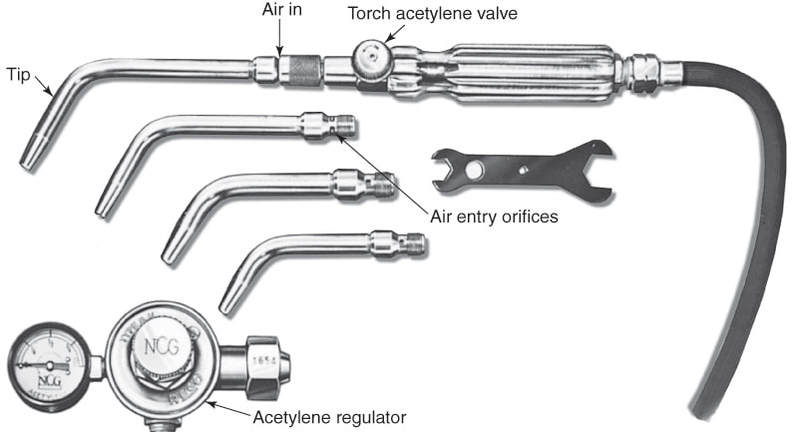11.7 Air-Acetylene Torches
An air-acetylene torch, Figure 11-49, is often used where a light portable flame with a medium temperature of 2500°F (1370°C) is required. This torch is used extensively on copper plumbing (soft soldering) and refrigeration lines (silver brazing). It is also used to solder or braze small parts. If large parts are to be silver-brazed, an oxyacetylene torch is recommended.
An air-acetylene torch receives its acetylene from a cylinder through a regulator and hose. As the acetylene flows through the torch, air is drawn in from the atmosphere to supply the oxygen needed for combustion. The torch operates on the same principle as a Bunsen burner used in chemistry laboratories.
The same safety precautions observed when handling an oxyacetylene torch should also be used when working with an air-acetylene torch.
Cylinders for small portable air-acetylene torches come in various capacities. Regular sizes are 10 ft3 (0.28m3) and 40 ft3 (1.14m3). The 10 ft3 (0.28m3) cylinder is called the MC size. The valve fittings on both of these cylinders are Prest-O-Lite (POL) fittings.
An air-acetylene torch receives its acetylene from a cylinder through a regulator and hose. As the acetylene flows through the torch, air is drawn in from the atmosphere to supply the oxygen needed for combustion. The torch operates on the same principle as a Bunsen burner used in chemistry laboratories.
The same safety precautions observed when handling an oxyacetylene torch should also be used when working with an air-acetylene torch.
Cylinders for small portable air-acetylene torches come in various capacities. Regular sizes are 10 ft3 (0.28m3) and 40 ft3 (1.14m3). The 10 ft3 (0.28m3) cylinder is called the MC size. The valve fittings on both of these cylinders are Prest-O-Lite (POL) fittings.

